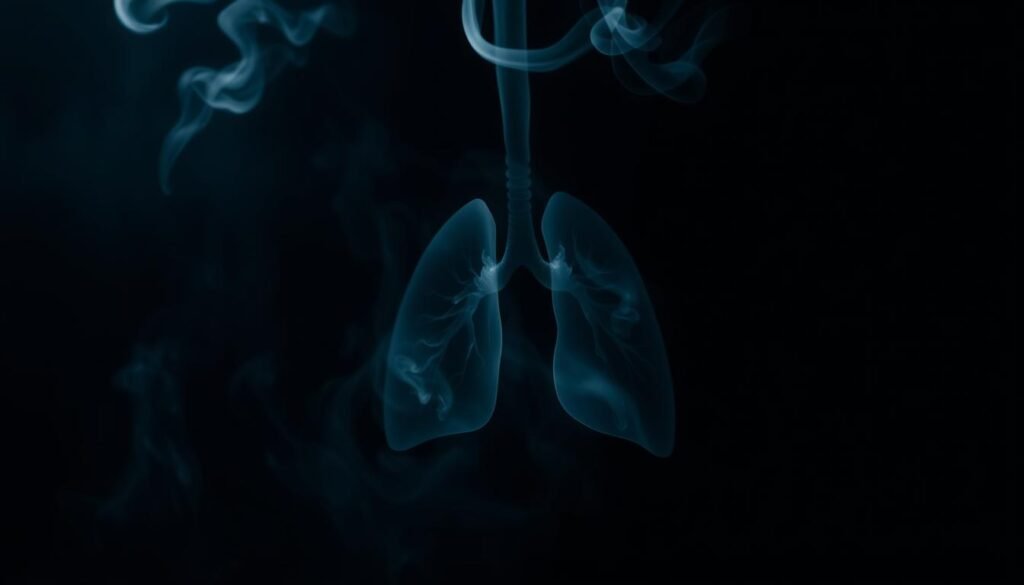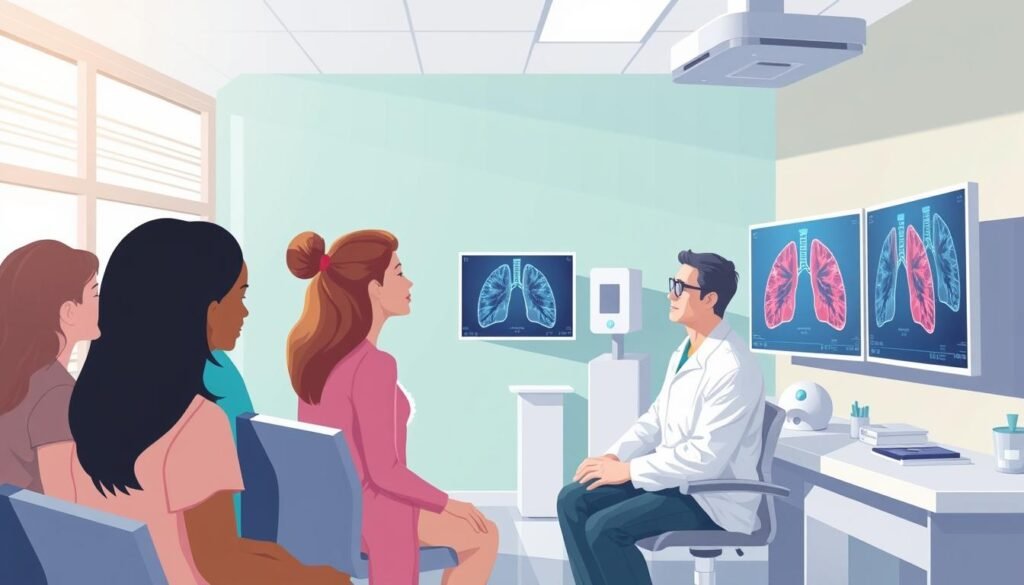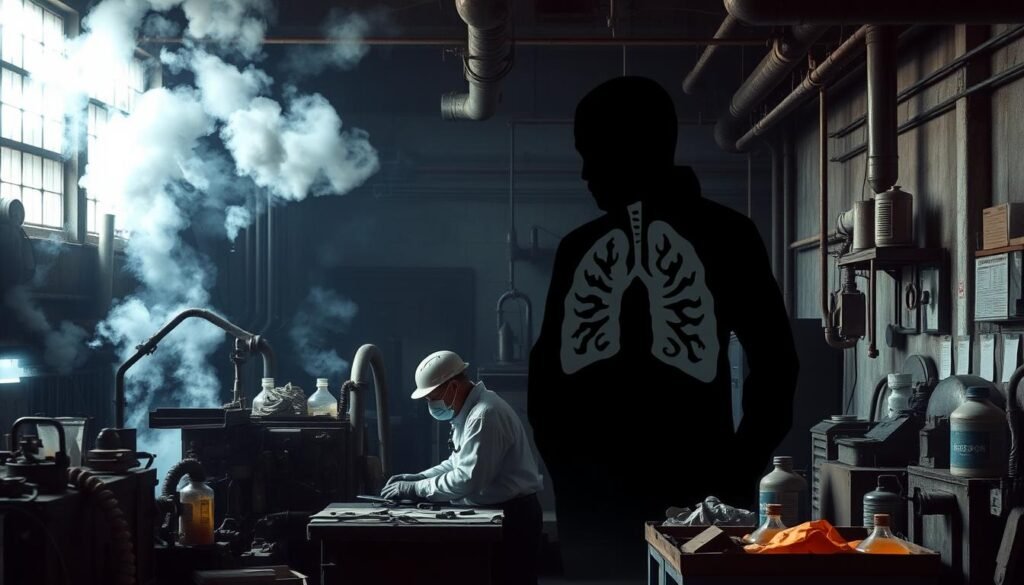About 80% of lung cancer deaths come from smoking. This big fact highlights why knowing lung cancer risks and early signs is key. Lung cancer is the top cause of cancer deaths globally. So, spotting it early can really make a difference.
Smoking is a big risk for lung cancer, for both smokers and those around them. Things like radon gas are also big risks, especially for people who don’t smoke. Being aware of dangers like asbestos at work is important too. Knowing these risks and the early signs of lung cancer can save lives.
Key Takeaways
- About 80% of lung cancer deaths are linked to smoking.
- Secondhand smoke is the third most common cause of lung cancer in the U.S.
- Radon gas exposure is a significant risk factor for non-smokers.
- Workplace exposure to carcinogens can increase lung cancer risk, especially for smokers.
- Recognizing early lung cancer symptoms can lead to better outcomes.
Understanding Lung Cancer
Lung cancer starts from lung cell abnormalities, often due to genetic changes. Smoking is the main cause, leading to about 90 percent of cases. There are two main types: small cell lung cancer (SCLC) and non-small cell lung cancer (NSCLC).
SCLC is mostly seen in those who have smoked for many years. NSCLC can occur in both smokers and non-smokers. People with family members who had lung cancer are at more risk. If lung cancer has affected your family, your risk increases even more.
We’re learning more about different lung cancers and what makes them tick. This knowledge highlights how environment and genes can affect our health. It shows lung cancer’s complexity, pointing to both outside factors and genetic risks.
Below is a table showing how certain behaviors and environments link to lung cancer:
| Factor | Impact | Statistics |
|---|---|---|
| Cigarette Smoking | Leading cause of lung cancer | 90% of lung cancer cases |
| Family History | Increases risk | 2x higher for those with a family history |
| Radon Exposure | Second leading cause of lung cancer | 1 in 15 homes in the U.S. affected |
| Asbestos Exposure | Significant workplace hazard | 70% to 80% of mesothelioma cases linked |
| Air Pollution | Contributes to lung cancer risk | Increased risk from particle pollution |
What Are the Common Symptoms of Lung Cancer?
Lung cancer often doesn’t show symptoms until it’s advanced. This makes knowing what to watch for very important. If some signs do appear early, it’s crucial to get medical help fast.
The common lung cancer symptoms include:
- A persistent cough that does not go away
- Coughing up blood or rust-colored sputum
- Chest pain that worsens with deep breathing
- Hoarseness and changes in voice
- Loss of appetite along with unexplained weight loss
- Shortness of breath and fatigue
- Recurring infections in the lungs
As lung cancer grows, more symptoms may appear. These include wheezing, bone pain, and nervous system changes. People might also see jaundice and swollen lymph nodes. Certain cancers, like Pancoast tumors, can cause Horner syndrome. This leads to drooping eyelids and smaller pupils. Superior vena cava syndrome can swell the face and neck, making breathing hard.
Paraneoplastic syndromes are also linked to lung cancer. They release substances that affect distant organs. Knowing these lung cancer signs helps catch the disease early. Early detection is key for effective treatment.
Factors That Increase Lung Cancer Risk
Lung cancer is a major health issue. Knowing what raises your risk is key to stop it. Smoking is a big cause, making up about 80% of lung cancer deaths. This includes not just cigarettes, but also cigars and pipes.
Being around smoke when you don’t smoke also matters. It ups lung cancer risk by 20% to 30% for these folks. This shows how vital it is to stay away from smoking areas. Besides tobacco, things like radon gas push up the risk too. The US Environmental Protection Agency says radon is the second top cause of lung cancer.
Jobs can raise your risk if you’re around dangerous stuff. People working with asbestos face a higher lung cancer danger, especially if they smoke. Pollution in the air also plays a part in 5% of lung cancer deaths worldwide. It’s crucial to think about all the risk factors combined.
Your genes matter too. If lung cancer runs in your family, you might be more likely to get it. Studies have found that certain inherited changes could affect your risk. The risks for lung cancer are more than just smoking habits. They include your genes, where you work and live, and the air you breathe. Understanding these factors helps in preventing the disease.
| Risk Factor | Details |
|---|---|
| Smoking | Responsible for about 80% of lung cancer deaths. |
| Secondhand Smoke | Increases risk by 20% to 30% for non-smokers living with smokers. |
| Radon Exposure | Second leading cause of lung cancer, especially in non-smokers. |
| Asbestos | Workers exposed are several times more likely to develop lung cancer. |
| Outdoor Air Pollution | Accounts for approximately 5% of lung cancer deaths globally. |
| Family History | Inherited genetic mutations may elevate risk. |
Risk Factors: Smoking and Its Impact
Smoking is the top cause of lung cancer, causing 80% to 90% of deaths. The more you smoke, the bigger the risk becomes. Smokers have up to a 30 times higher chance of getting lung cancer than non-smokers. But, quitting can really lower your risk, even if you’ve smoked for years.
About 235,000 new cases of lung cancer pop up in the U.S. every year. This results in 130,000 to 160,000 deaths annually. Despite efforts to control tobacco, between 2015 and 2065, as many as 4.4 million people could die from lung cancer because of smoking.
Lung cancer rates drop as fewer people smoke. This shows how vital it is to work on lowering lung cancer risks. Stopping smoking or cutting down on tobacco use is key.

Other tobacco products like pipes and cigars also increase the risk of lung cancer. Tobacco use leads to many health problems, including the top killer, COPD.
Public health campaigns should stress quitting smoking to reduce lung cancer rates. It’s important to keep young people from starting to smoke. And urge current smokers to stop. Understanding these issues helps in creating better plans to fight lung cancer.
For more on how smoking causes lung cancer, chronic inflammation, and other factors, see this detailed study.
Exposure to Secondhand Smoke
Secondhand smoke is a serious health concern. It affects people who don’t smoke, at a high cost. More than 7,300 nonsmokers die from lung cancer each year because of it. Being around secondhand smoke makes lung cancer 20 to 30% more likely for them.
But it’s not just lung cancer. Secondhand smoke causes about 34,000 premature heart disease deaths in the U.S. each year. Being exposed raises your stroke risk by 20 to 30%, which shows it’s bad for your heart too.
Kids are especially at risk from secondhand smoke. They could get more lung infections, worse asthma, or even sudden infant death syndrome (SIDS). It’s also about thirdhand smoke—the leftovers on surfaces—which harms kids and pets.
| Health Risks of Secondhand Smoke | Statistics |
|---|---|
| Lung cancer deaths among non-smokers | Over 7,300 annually |
| Increased risk of lung cancer in non-smokers | 20-30% |
| Premature deaths from heart disease | 34,000 annually |
| Risk of stroke increase | 20-30% |
| Deaths due to secondhand smoke exposure | More than 19,000 annually |
It’s key to stop secondhand smoke exposure. Doing so cuts down on lung cancer and early disease signs. Smoke-free places help everyone, improving community health. Teaching people about secondhand smoke risk can lead to better choices for public health.
Lung Cancer Risk Factors and Early Signs
Knowing how to detect lung cancer early can greatly increase the chance of successful treatment. It’s vital to recognize lung cancer signs early for higher survival rates. Symptoms like a persistent cough, chest pain, and losing weight without trying could signal trouble. Knowing these signs means you can act fast and possibly stop the disease.
Signs to Watch For
- New cough lasting more than three weeks
- Chest pain that gets worse when you breathe deeply
- Coughing up blood or rust-colored spit
- Feeling very tired and losing weight without a reason
- Having a hoarse voice and feeling short of breath often
Seeing these signs, especially if you’re at risk for lung cancer, means it’s time to check with a doctor. Paying attention to your body can lead to early diagnosis and fast treatment.
Importance of Early Detection
Finding lung cancer early is key to beating it. When found early, there are usually more options for treatment. Talking with your doctor about risks, like your family’s health history and your lifestyle, is important. Also, screening programs can catch cancer early in people who are at high risk. This early find means treatment can start before the cancer grows.

Environmental Factors Contributing to Lung Cancer
Some environmental factors greatly increase the risk of lung cancer. In particular, radon gas and air pollution are key culprits. It’s vital for people to be aware of these dangers to lower their risk.
Radon Gas Exposure
Radon gas is a radioactive substance that can build up inside homes and buildings, especially in lower areas like basements. It is the second leading cause of lung cancer after smoking. Despite its danger, many people do not know radon is present in their homes. Testing for radon can identify high levels and lead to actions that reduce risk. This can lower the dangers linked to radon gas and lung cancer.
Air Pollution and Its Effects
Air pollution is a big problem that adds to the risk of lung cancer. Breathing polluted air, full of harmful particles and diesel exhaust, harms everyone, not just smokers. About 108,000 lung cancer deaths were caused by outdoor air pollution. This shows the lethal link between air pollution and lung cancer. By fighting for cleaner air and lessening exposure to pollutants, we can greatly help public health.
To learn more about how environment affects lung cancer, check out this detailed article.
| Environmental Factor | Impact on Lung Cancer | Deaths Attributed |
|---|---|---|
| Radon Gas | Second leading cause of lung cancer | N/A |
| Outdoor Air Pollution | Elevates lung cancer risk | 108,000 deaths |
| Secondhand Smoke | Increases risk for non-smokers | 21,000 deaths |
Workplace Hazards and Carcinogens
Being exposed to carcinogens at work can seriously affect your health, leading to diseases like lung cancer. It’s very important for both workers and their bosses to know about these dangers. They need to work together to reduce exposure. The link between asbestos and lung cancer is well-known, especially in industries like construction.
Asbestos and Its Association with Lung Cancer
Asbestos was used a lot in the past for building and manufacturing. It’s harmful and can cause lung cancer. If you breathe in asbestos fibers over a long time, your risk goes up. This is especially true for people working in mines, on ships, and at construction sites. Because of its dangers, there are rules now to keep workers safe from asbestos. Around 10% of lung cancer cases are due to working with carcinogens like asbestos.
Chemical Exposures in the Workplace
Other chemicals at work can also cause lung cancer. Some of these are arsenic, nickel, and dangerous dust. People who work with metals, paint, or chemicals are at risk. Every year, these job hazards lead to thousands of cancer cases. To stop this, workplaces must follow safety rules, check the air, and teach workers about the risks. This helps keep everyone healthier and safer.

Prevention Strategies for Lung Cancer
There are many ways to prevent lung cancer. These include avoiding smoking and choosing a healthy lifestyle. While we can’t stop lung cancer completely, we can greatly lower the risk.
Quitting Smoking
Stopping smoking is the best way to avoid lung cancer. In the U.S., smoking causes 90% of lung cancer cases. Smokers are about 20 times more likely to get lung cancer than non-smokers. Once you quit, your health improves quickly. In up to 10 years, your lung cancer risk drops by 30% to 60%.
Healthy Lifestyle Choices
Eating well and being active can also reduce lung cancer risk. It’s important to eat lots of fruits and veggies. The American Cancer Society says this diet could help lower your risk. Staying active, avoiding cancer-causing agents, and reducing radon exposure can help too. Remember, eating real food is better than taking supplements for immune health.
| Prevention Strategy | Description | Outcome |
|---|---|---|
| Quitting Smoking | Stop the use of tobacco products, which is the leading cause of lung cancer. | Decreased risk of lung cancer by 30%-60% within 10 years. |
| Healthy Diet | Increase intake of fruits and vegetables to support lung health. | Potential reduction in lung cancer risk. |
| Regular Exercise | Engage in physical activity to maintain overall health. | Improved immune system and lower cancer risk. |
| Avoid Carcinogens | Minimize exposure to harmful substances like radon and asbestos. | Lower risk of developing lung cancer associated with environmental hazards. |
Conclusion
Knowing lung cancer risks and early signs is key for prevention and treatment. In 2019, the U.S. might see about 228,150 new cases. It shows why ongoing education on this issue is crucial.
People can lower their risk by making smarter life choices and getting regular checks. Although only 19% survive past five years, early detection can help a lot. It can lead to better chances of beating the disease through efforts like screenings.
Since smoking greatly increases lung cancer risk, quitting is a big step towards better health. Despite lung cancer being a top killer, understanding and taking action early offers hope. Recognizing symptoms, such as a lasting cough and finger clubbing, is vital. This awareness can prompt quicker diagnosis and treatment, saving lives.
Health experts keep pushing lung cancer prevention methods, which is important for everyone. Knowing how environment and genes play a role helps people fight against lung cancer. With more focus on learning about this disease early, we’re moving towards better diagnosis and care. This could mean higher survival rates and a brighter future for many.